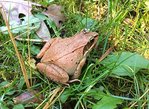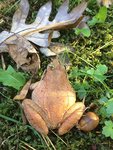 Narrowsburg
NarrowsburgLight Rain Fog/Mist, 43°
Wind: 8.1 mph
 Narrowsburg
NarrowsburgWhile raking leaves in my yard recently, one suddenly leapt away from me. Similar in color to the foliage on the ground, the leaper turned out to be a wood frog, who probably didn’t appreciate …
Stay informed about your community and support local independent journalism.
Subscribe to The River Reporter today. click here
This item is available in full to subscribers.
Please log in to continue |


While raking leaves in my yard recently, one suddenly leapt away from me. Similar in color to the foliage on the ground, the leaper turned out to be a wood frog, who probably didn’t appreciate my disruption. The truth is, most animals prefer their habitats to be ungroomed, and as unaltered from their natural state as possible. My yard leans decidedly (and by choice) in this direction, so I often encounter interesting life forms quite close to (and sometimes inside!) my home.
After ascertaining that my cleanup hadn’t caused the frog any physical harm, I snapped a few photos to share here.
As temperatures drop and while I am warm inside my home, my amphibian neighbor will overwinter in the leaf litter, even becoming frozen until the spring thaw begins between late March and early April.
In a truly miraculous process, wood frogs create their own anti-freeze, enabling them to survive the winter with two-thirds of their body completely frozen. Entering a state of suspended animation that earns it the nickname “frogsicle,” the wood frog’s heart stops beating and its respiration ceases. Visit https://tinyurl.com/ybw2skzw and https://tinyurl.com/y9dtoqhp to learn more about this fascinating natural phenomenon.
Come spring in the Upper Delaware River region, wood frogs are the first to emerge from hibernation. You’ll know this event is underway when you hear a sound reminiscent of “quacking,” emanating from vernal (spring) pools throughout the region. Not be mistaken for ducklings, the intriguing sound is a true harbinger that the seasons are advancing, as males call out for mates, often before the ice has melted from breeding ponds.
Meanwhile, consider letting your yard be as natural as possible to make room for other life forms. You never know who might move in to share your habitat!
Comments
No comments on this item Please log in to comment by clicking here